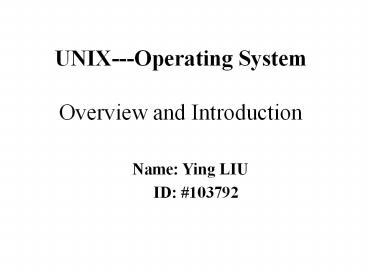UNIX---Operating System Overview and Introduction PowerPoint PPT Presentation
Title: UNIX---Operating System Overview and Introduction
1
UNIX---Operating System
Overview and
Introduction
- Name Ying LIU
- ID 103792
2
Contents
- Overview
- History
- Variants
- Architecture
- Commands
- Files and Directories
- Security
- Application
- Conclusion
3
UNIX Overview
- What is UNIX?
- narrow sense is a computer operation system
- wider sense encompasses a broad set of commands,
or utilities - What does it do?
- operates a computer
- lets a number of programmers access the computer
4
- The Uniqueness of UNIX
- Multitasking capability
- Running more than one tasks at same time
- Multiuser capability
- multitasking permits multiple users to use the
computer - Portability
- move from one brand of computer to another with a
minimum of code changes - UNIX programs
- Integral utilities
- Tools
- Library of application software
5
UNIX History
- Bell Lab
- Ken Thompson Dennis Ritchie Doug McIlroy
Brian Kernighan
- 1960s--dependable timesharing OS
- 1970--PDP-7, CTSS, Multics
- 1974--rewritten in C
- 1975--Version 6
6
(No Transcript)
7
Figure 1. Relationship of UNIX System Variants
with UNIX SVR4
8
UNIX Variants
9
UNIX Architecture
- Kerenel
- schedules tasks and manages storage
- Shell
- connects and interprets users' commands
- calls programs from memory and executes them
- Tools and Applications
- offer additional functionality to the operating
system
10
Tools
Shell
Kernel
Hardware
Applications
Figure 2. General UNIX Architecture
11
(No Transcript)
12
Types of Shells
13
- Function of Shells
- Interpret commands entered at the command line
prompt when running interactively. - Customize the users environment, normally done
in shell initialization files - Be used as an interpreted programming language
14
- Tools and Applications
- hundreds of tools available
- certain functions
- such as word processing, business applications,
or programming
15
UNIX Commands
- Types of Commands
- Aliases--define within the shells memory
- Built-in commands-- are internal routines in the
shell - Functions-- define within the shells memory
- Executables programs --reside on disk
16
- Generic Syntax
- Command flags argument1 argument2
- Basic Commands
- logging on (rlogin)
- changing password (passwd)
- getting out (exit), listing files (ls)
- copying files (cp)
- removing files (rm)
- navigating the directory tree (cd)
- so on.
17
UNIX Files and Directory
- Hierarchical file system
- files are organized in a top-down, or inverted
tree, structure - Tree-structured directory
18
(No Transcript)
19
- Four types of file system
- Regular file system Files that contain
information entered in them by a user, an
application program, or a system utility program. - Directory file system contains a list of file
names plus pointers to associated inodes (index
nodes).. - Device file system used to access peripheral
devices, such as terminals and printers. Each I/O
device is associated with a special file. - Named file system named pipes. A pipe is a
circular buffer allowing two processes to
communicate on the producer-consumer model.
20
UNIX Security
- Risk and Treat
- Risk the possibility of an intruder attempting
to access - Treat the motivation to attempt to gain
unauthorized access - Protection
- Password system
- Intrusion detection
21
- There are four general categories of attack
- Interruption an asset of the system is destroyed
or becomes unavailable or unusable. This is an
attack on availability. - Interception an unauthorized party gains access
to an asset. This is an attack on
confidentiality. - Modification an unauthorized party not only
gains access to but tampers with an asset. This
is an attack on integrity. - Fabrication an unauthorized party inserts
counterfeit objects into the system. This is an
attack on authenticity.
22
- Table 2 Network Security Architecture
- --------------------------------------------------
--------------------------------------------- - Layer Name
Functional Description - --------------------------------------------------
--------------------------------------------- - Layer 7 Policy
Policy Definition And Directives - Layer 6 Personnel People
Who Use Equipment And Data - Layer 5 LAN
Computer Equipment And Data Assets - Layer 4 Internal-Demark Concentrator -
Internal Connect - Layer 3 Gateway
Functions For OSI 7, 6, 5, 4 - Layer 2 Packet-Filter Functions
For OSI 3, 2, 1 - Layer 1 External-Demark Public Access
- External Connect - --------------------------------------------------
-------------------------------------------
23
UNIX Applications
- Horizontal applications
- not specific to any particular industry. Are used
throughout academia, government, and the
commercial world - Vertical applications
- are used for applications designed to solve
problems in specific industries such as
retailing, hotel management, or finance.
24
Conclusion
- Many of UNIXs approaches and notations have
influenced the entire span of subsequent
operating systems. - Thirty years after its creation, UNIX still
remains a phenomenon!.
25
References
- Ellie Quigley UNIX Shells by Example, second
edition.. 1999 by Prentice Hall PTR. ISBN
0-13-02-12229. - Stephen Prata, Donald Martin, The Waite Group
UNIX System V Bible--Commands and Utilites.. 1987
by The Waite Group, Inc. first edition. ISBN
0-672-22562. - Ralph M. Stair and George W. Reynolds Principles
of Information System, Fourth Edition. 1000 by
Course Technology. ISBN 0-7600-1079-X. - William Stallings Operating Systems Internals
and Design Principles. Third Edition. 1998 by
Prentice hall Engineering, Science Math. ISBN
0-13-887407-7. - Kenneth H Rosen, Douglas A Host, James M. Farber,
Richard R Rosinski. UNIX The complete Reference.
1999 by The McGraw-Hill Companies. ISBN
0-07-211892-X. - http//www.bell-labs.com/history/UNIX
- http//www.msoe.edu/taylor/4ltrwrd/
26
Acknowledgment
- I gratefully thank Professor M. Anvari for the
suggestion on the paper organization.

